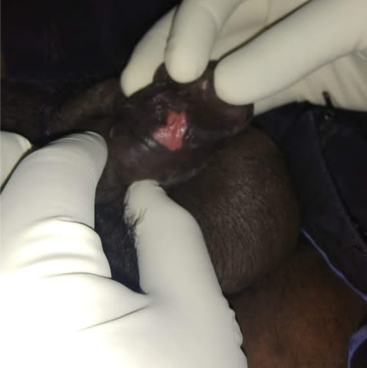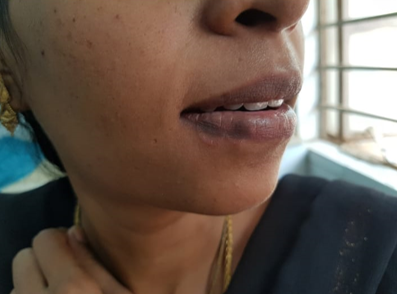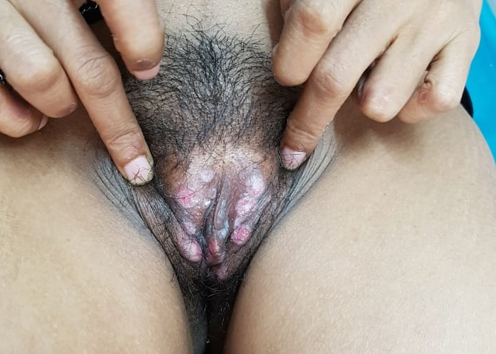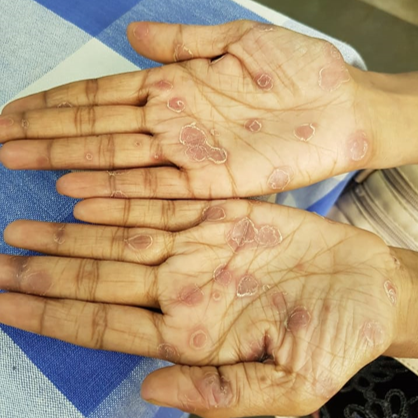- Visibility 314 Views
- Downloads 40 Downloads
- Permissions
- DOI 10.18231/j.ijced.2025.013
-
CrossMark
- Citation
Factors influencing complete treatment in patients having syphilis and their partners in a tertiary care hospital - A cross sectional study
- Author Details:
-
Nivetha P P
-
Subashini M R *
-
Premchand T R
-
Manju T M
Abstract
Introduction: Syphilis is caused by the bacterium Treponema pallidum. It remains a significant public health concern, particularly due to its resurgence globally. This study investigates the factors influencing treatment completion among patients with syphilis and their partners in a tertiary care hospital. This also highlights the critical role of early diagnosis and treatment adherence.
Materials and Methods: A cross-sectional study was conducted at college from August 2022 to August 2023. It involved 57 patients diagnosed with syphilis via the Rapid Plasma Reagin (RPR) test. Data collection included socio-demographic details, sexual history, and clinical examination. Treatment adherence was categorized as complete or incomplete based on predefined criteria. Descriptive statistics and chi-square tests were used to analyze factors influencing treatment outcomes.
Results: Of the 57 participants, 39 had completed treatment. While 11 had incomplete treatment and 7 were untreated. Significant factors influencing treatment adherence included occupation (p=0.049) and distance from the hospital (p=0.033). High-risk behaviors, such as promiscuity (40.4%) and a history of alcoholism (29.8%), were associated with incomplete treatment (p=0.050, p=0.036). Non compliance reasons included fear of disclosing infidelity (28.7%) and reluctance to seek treatment (28.7%).
Conclusion: This study depicts the multifaceted challenges in achieving complete treatment for syphilis, influenced by socio-demographic factors and high-risk behaviors. The findings highlight the urgent need for targeted interventions, including enhanced counseling, partner notification strategies, and community awareness campaigns to improve treatment outcomes and reduce syphilis transmission.
Introduction
Syphilis, a persistent sexually transmitted illness (STI) caused by the spirochete bacteria Treponema pallidum subsp. pallidum, is a major threat to public health worldwide. It is distinguished by a complicated clinical history that encompasses both symptomatic and asymptomatic stages. The illness can affect several organ systems and frequently mimics other disorders, making proper diagnosis a problem across numerous medical professions.[1]
Syphilis is divided into two types: infectious (early) and non-infectious (late) syphilis. Infectious syphilis is particularly problematic because of its transmission implications, including a significantly increased risk of HIV transmission, with syphilis increasing the probability of obtaining HIV fourfold. [2], [3] Furthermore, syphilis during pregnancy is linked to serious unfavourable outcomes such as stillbirth and congenital syphilis, which have an impact on both maternal and newborn health. [4]
According to epidemiology, syphilis has been on the rise in many areas, especially among marginalized groups and men who have sex with men (MSM). [5] The incidence and prevalence of early syphilis are on the rise worldwide, according to data from the World Health Organization (WHO), especially in underdeveloped nations where access to screening and treatment may be restricted. [6] Sexual behaviour, partner traits, and preventative measures like using condoms are some of the many variables that affect the spread and acquisition of syphilis. Previous research has shown that the dynamics of syphilis transmission are greatly influenced by variables such the frequency and kind of sexual contacts, the diseased partner's stage of syphilis, and the presence of many or anonymous partners. [7], [8]
The effective management of syphilis relies heavily on early diagnosis and treatment. The primary treatment strategy involves the administration of appropriate antibiotics, typically penicillin, to both the patient and their sexual partners. Education and counseling about the disease play critical roles in promoting treatment adherence and preventing reinfection. Despite the availability of effective treatment, many patients do not complete their prescribed regimens, leading to ongoing transmission and complications associated with untreated syphilis. [9]
This study aims to assess the percentage of patients and their partners who complete the recommended treatment for syphilis, as well as to identify the factors influencing treatment adherence. Understanding these dynamics is essential for developing targeted interventions to improve treatment outcomes and reduce the transmission of syphilis.
Aim
To study the factors influencing the completion of treatment in patients diagnosed with syphilis and their partners in a tertiary care hospital.
Objectives
To determine the prevalence of complete treatment among syphilis patients and their partners.
To analyze the factors contributing to incomplete treatment in syphilis patients and their partners.
Materials and Methods
Study design
This cross-sectional study was conducted in the Department of Dermatology, Venereology, and Leprology (DVL) at Kanyakumari Government Medical College (KGMCH) over a period of one year, from August 2022 to August 2023. The study was approved by the Institutional Ethical Committee (IEC).
Study population
The study included a total of 57 patients who tested positive for syphilis via the Rapid Plasma Reagin (RPR) test and attended the Sexually Transmitted Disease (STD) Outpatient Department during the study period. All participants provided informed consent before enrollment.
Inclusion criteria
Patients testing positive for syphilis through the RPR test.
Patients willing to participate in the study and complete follow-up.
Exclusion criteria
Patients with false-positive RPR results.
Partners of late latent syphilis (LLS) patients who tested non-reactive on both the RPR and Treponema Pallidum Hemagglutination Assay (TPHA) tests.
Data collection
After obtaining informed consent, data were collected using a structured proforma. Socio-demographic information, including age, gender, literacy, occupation, and place of residence, was documented. A detailed clinical and sexual history was recorded, focusing on:
Marital status.
Sexual behavior (promiscuous or non-promiscuous).
Sexual orientation (heterosexual, homosexual, bisexual).
High-risk behaviors such as men having sex with men (MSM), intravenous drug use, alcoholism.
History of sexually transmitted diseases (STDs) and previous treatment.
High-risk groups such as female sex workers (FSW), antenatal mothers (ANC), and patients on antiretroviral therapy (ART).
Clinical examination
Thorough physical examination was conducted, including:
General and dermatological examination.
Genital and mucosal examination (oral, anal).
Palms, soles, nails, and hair were meticulously examined.
Specific focus on anogenital examination for ulcers, discharges, growths, rashes, or scars.
Oral mucosa was checked for any ulcers or growths.
Laboratory tests/ Serological testing
All patients underwent syphilis screening using the RPR test, with positive results confirmed by TPHA. Patients with false-positive RPR results were excluded from the study. The stage of syphilis was classified based on RPR titers, with early (infectious) syphilis and late (non-infectious) syphilis identified accordingly.
Treatment protocol
Patients with early syphilis were treated with a single dose of intramuscular Benzathine Penicillin 2.4 million IU. Patients with late syphilis received three doses of Benzathine Penicillin at weekly intervals. Patients were counseled regarding the importance of completing the treatment regimen and bringing their sexual partners for screening and treatment.
Partner involvement
Partners of patients with early syphilis were advised to receive a single dose of Benzathine Penicillin (epidose). Partners of patients with LLS were excluded from treatment if they tested non-reactive for RPR and TPHA.
Follow-up
Patients were followed up for a period of two years. For those with incomplete treatment, phone calls were made to assess the reasons for noncompliance, and additional counseling was provided to emphasize the need for completing treatment.
Outcome definitions
Full course of therapy (early syphilis): The patient and their partner finished the recommended one-dose course of Benzathine Penicillin.
Full therapy (late syphilis): The patient finished the entire three-dose course of Benzathine Penicillin.
Inadequate treatment: Individuals or their partners did not finish the recommended course of action.
Statistical analysis
Microsoft Excel was used to enter the data, and SPSS software (version 25.5) was used for analysis. For categorical variables, such as gender, sexual behaviour, and partner treatment status, descriptive statistics like frequencies and percentages were computed. Age and other continuous variables were shown as means with standard deviations (SD).
To investigate the relationship between different sociodemographic and behavioural characteristics and categorical variables like treatment compliance, the chi-square test was utilized. The threshold for statistical significance was p < 0.05.
Results
[Table 1] Socio-demographic characteristics of study population
Of the 57 participants in the research, the majority (57.9%) were male (66.7%) and between the ages of 21 and 40. 39 individuals received full therapy, 11 received partial treatment, and 7 received no treatment, according to the treatment distribution. The odds of receiving full treatment were lower for daily wagerers and those who lived more than 10 km from the hospital, according to statistically significant differences in profession (p=0.049) and distance from the hospital (p=0.033).
[Table 2] High-risk factors/Groups and sexual orientation
The majority of the population (52.6%) identified as heterosexual, and there were no appreciable variations in treatment results between sexual orientation groups. Nonetheless, substantial high-risk characteristics were identified: treatment disparities were considerable for those with a history of alcoholism (29.8%) and those classified as promiscuous (40.4%) (p=0.050 and p=0.036, respectively). Additionally, individuals with unknown partners had a reduced treatment rate (p=0.000), and those having protected sex had a higher probability of receiving therapy (p=0.016).
[Table 3] Statistical evaluation of syphilis clinical staging
Regarding clinical staging, 47.4% of patients had early latent syphilis upon presentation. Although there were substantial changes in treatment outcomes between phases, there were no statistically significant differences between the main (p=0.828) and late latent syphilis stages.
[Table 4] Causes of inadequate or nonexistent care
The most frequent excuses given by patients (n=7) for not finishing therapy were reluctance to seek treatment (28.7%) and fear of disclosing infidelity (28.7%). Fear of exposure also came in first (31.25%) for partners (n=16), followed by not having a regular partner (25%). Other important variables for both groups included distance from the hospital and migrant labour.
|
Age (in years) |
|
|
|
|
|
|
<20 |
2 (3.5 %) |
0 |
1 (9.1%) |
1 (14.3%) |
0.184 |
|
21-40 |
33 (57.9%) |
24 (61.5%) |
7 (63.6%) |
2 (28.6%) |
|
|
41-60 |
16 (28.1%) |
12 (30.8%) |
2 (18.2%) |
2 (28.6%) |
|
|
>60 |
6 (10.5%) |
3 (7.7%) |
1 (9.1%) |
2 (26.6%) |
|
|
Gender |
|
|
|
|
|
|
Male |
38 (66.7%) |
24 (61.5%) |
8 (72.2%) |
6 (85.7%) |
0.409 |
|
Female |
19 (33.3%) |
15 (38.5%) |
3 (27.3%) |
1 (14.3%) |
|
|
Education |
|
|
|
|
|
|
Degree |
17 (29.8%) |
12 (30.8%) |
4 (36.4%) |
1 (14.3%) |
0.129 |
|
Primary |
8 (14%) |
6 (15.4%) |
0 (0%) |
2 (28.6%) |
|
|
Secondary |
28 (49.1%) |
20 (51.3%) |
6 (54.5%) |
2 (28.6%) |
|
|
Uneducated |
4 (7%) |
1 (2.6%) |
1 (9.1%) |
2 (28.6%) |
|
|
Occupation |
|
|
|
|
|
|
Daily wagers |
27 (47.4%) |
22 (56.4%) |
2 (18.2%) |
3 (42.9%) |
0.049* |
|
Monthly wagers |
16 (28.1%) |
10 (25.6%) |
5 (45.5%) |
1 (14.3%) |
|
|
Unemployed |
11 (19.3%) |
6 (15.4%) |
2 (18.2%) |
3 (42.9%) |
|
|
House Wife |
1 (1.8%) |
1 (2.6%) |
0 (0%) |
0 (0%) |
|
|
Female sex worker |
2 (3.5%) |
0 (0%) |
2 (18.2%) |
0 (0%) |
|
|
Marital H/O |
|
|
|
|
|
|
Married |
46 (80.7%) |
33 (84.6%) |
7 (63.6%) |
6 (85.7%) |
0.279 |
|
Unmarried |
11 (19.3%) |
6 (15.4%) |
4 (36.4%) |
1 (14.3%) |
|
|
Location |
|
|
|
|
|
|
< 10KM from hospital |
40 (70.2%) |
29 (74.4%) |
9 (81.8%) |
2 (28.6%) |
0.033* |
|
> 10KM from hospital |
17 (29.8%) |
10 (25.6%) |
2 (18.2%) |
5 (71.4%) |
|
Parameters |
Study Population (n=57) |
Complete treatment (n=39) |
Incomplete treatment (n=11) |
Untreated (n=7) |
P value |
|
Sexual orientation |
|
|
|
|
|
|
Heterosexual |
30 (52.6%) |
22 (56.4%) |
6 (54.5%) |
2 (28.6%) |
0.394 |
|
Men having sex with men (MSM) |
9 (15.8%) |
6 (15.4%) |
2 (18.2%) |
1 (14.3%) |
0.767 |
|
Bisexual |
18 (31.6%) |
11 (28.2%) |
3 (27.3%) |
4 (57.1%) |
0.398 |
|
High risk actors/group |
|
|
|
|
|
|
Promiscuous |
23 (40.4%) |
13 (56.5%) |
8 (34.8%) |
2 (8.7%) |
0.050 |
|
Alcoholism |
17 (29.8%) |
9 (52.9%) |
3 (17.6%) |
5 (29.4%) |
0.036* |
|
Intravenous drug user |
0 (0%) |
- |
- |
- |
- |
|
HIV coinfected patients |
17 (29.8%) |
13 (76.5%) |
3(17.6%) |
1 (5.9%) |
0.585 |
|
Antenatal patients |
6 (10.5%) |
6 (100%) |
0 |
0 |
0.213 |
|
Partner notification status and report condom usage |
|
|
|
|
|
|
Known partner |
47 (82.5%) |
39 (83%) |
3 (6.4%) |
5 (10.6%) |
0.000 * |
|
Unknown partner |
10 (17.5%) |
0 |
8 (80%) |
2 (20%) |
|
|
Protected sex |
8 (14%) |
2 (25%) |
4 (50%) |
2 (25%) |
0.016 * |
|
Unprotected sex |
49(49%) |
37(75.5%) |
7(14.3%) |
5(10.2%) |
|
Stages of Syphilis |
Study Population (n=57) |
Complete treatment (n=39) |
Incomplete treatment (n=11) |
Untreated (n=7) |
P value |
|
Primary Syphilis |
7 (12.3%) |
5 (71.4%) |
2 (28.6%) |
0 |
0.828 |
|
Secondary syphilis |
15 (26.3%) |
11 (73.3%) |
3 (20%) |
1(6.7%) |
|
|
Early latent syphilis |
27 (47.4%) |
17 (63%) |
5 (18.5%) |
5 (18.5%) |
|
|
Late latent syphilis |
8 (14%) |
6 (75%) |
1 (12.5%) |
1 (12.5%) |
|
Reason |
incomplete/ no treatment in patients (n = 7) |
Percentage % |
|
Fear of getting revealed about infidelity |
2 |
28.7 |
|
Not willing for treatment |
2 |
28.7 |
|
Non traceable |
1 |
14.2 |
|
Migrant labour |
1 |
14.2 |
|
Distance from hospital |
1 |
14.2 |
|
Reason |
Incomplete/ no treatment in partners (n = 16) |
Percentage % |
|
Fear of getting revealed about infidelity |
5 |
31.25 |
|
Not having regular partner |
4 |
25 |
|
Not willing for treatment |
3 |
18.75 |
|
Migrant labour |
2 |
12.5 |
|
Distance from hospital |
1 |
6.25 |
|
Non traceable |
1 |
6.25 |




Discussion
This study examines the factors influencing complete treatment in patients with syphilis and their partners in a tertiary care hospital. The findings highlight important challenges related to treatment adherence, high-risk behaviors, and partner notification, which have been observed in previous research on syphilis management.
In our study, promiscuous behavior was identified as the most significant risk factor, with 40.35% of participants reporting such conduct. This aligns with findings from Solaimalai et al. [10] (2022), where 51.3% of subjects exhibited similar behaviors. Notably, bisexual men (35.09%) and men who have sex with men (MSM) (12.28%) were also prevalent in our sample. These results echo the study by Solaimalai et al., [10] which found that 7.5% of MSM were positive for syphilis.
The importance of treating both index cases and their partners cannot be overstated, as untreated individuals significantly contribute to the transmission of syphilis and other sexually transmitted infections (STIs). In our cohort, we discovered that a substantial number of MSM patients (14.28%) and their partners (42.85%) had not received treatment. Moreover, 85.96% of subjects reported engaging in unprotected sex, underscoring the urgent need for awareness campaigns on safe sexual practices, condom usage, and the availability of free condoms through healthcare institutions and NGOs in India.
Early diagnosis and timely treatment are critical to curbing the spread and progression of syphilis. In our study, nearly half (47.37%) of patients were found to be in the early latent stage of syphilis, with additional cases of secondary and late latent syphilis. This finding is consistent with Jeevanandham et al.,[11] who reported 60.6% of subjects having latent syphilis . The increasing trend in latent cases can be attributed to multiple factors, including failures in early diagnosis, treatment noncompliance, decreased partner notifications, and the overuse of over-the-counter antibiotics. Additional diagnoses during routine blood screenings and mandatory antenatal screening programs also contribute to identifying latent cases. [12]
Co-infection with HIV is a major risk factor for syphilis treatment and community dissemination of the disease. The necessity of frequent syphilis screening for all HIV-positive patients visiting ART clinics is highlighted by the fact that 29.82% of syphilis cases in our sample were co-infected with HIV. We found that 12.28% of our subjects did not receive therapy, despite 87.72% receiving it. Of the MSM, 14.28% did not receive treatment, and 5.9% of the 17 HIV-positive patients did not receive treatment. According to the data, there were notable discrepancies in treatment adherence, with 67.34% of partners receiving therapy and 32.65% not.
In our study, noncompliance was caused by a variety of variables. Some individuals (28.57%) declined therapy because they were afraid of disclosing adultery, while others gave excuses such as a lack of knowledge about the illness, hectic work schedules, or a preference for complementary therapies. Effective follow-up was further hampered by non-traceability brought on by inaccurate contact information and regional restrictions. The causes of noncompliance among partners were similar to those reported in research by Nakku Joloba et al. [13] and Alam et al. [14] where major obstacles included stigma, rejection anxiety, and trouble reaching casual partners.
We stress the importance of partner notification measures in reducing the spread of syphilis. Disease transmission can be considerably decreased by employing tactics like patient-delivered partner medicines (PDPM) and patient-based partner referral (PBPR). In order to effectively manage syphilis in the community, it is imperative that these interventions be strengthened, as noted by Arunkumar et al. [15] To maintain anonymity and promote testing and treatment, more extensive counselling and awareness initiatives backed by governmental and non-governmental groups are required. This procedure may be made much easier by giving STI counsellors and medical professionals contact forms and home sample kits.
Limitations
This study has several limitations. The small sample size restricts the generalizability of the findings to broader populations. Additionally, reliance on self-reported data may introduce bias, particularly regarding sensitive issues like infidelity. The limited geographic scope further confines the applicability of the results to other socio-economic or cultural contexts. Lastly, the lack of long-term follow-up prevents a thorough evaluation of the impact of interventions such as patient-delivered partner medication on syphilis transmission over time.
Conclusion
This study identified several factors contributing to non-compliance with syphilis treatment among patients and their partners, including fear of infidelity being exposed, reluctance to seek treatment, migratory status, and geographical barriers. These factors highlight the challenges in ensuring complete treatment and partner management in sexually transmitted infections (STIs). The study underscores the importance of patient-delivered partner medication (PDPM) for those who cannot access healthcare facilities easily, such as migrant laborers or those living far from hospitals, to break the transmission chain of syphilis within the community.
Recommendations
To enhance treatment compliance and curb syphilis transmission, we recommend implementing patient-delivered partner medication (PDPM) for partners unable to access care. Healthcare providers should prioritize comprehensive counseling, emphasizing disease progression and confidentiality. Additionally, early screening, rapid testing in remote areas, and increased awareness of safe sex practices are crucial for reducing new infections.
Source of Funding
None.
Conflict of Interest
None.
References
- Jackson R. The Green Monster: Stokes's 1944 Modern Clinical Syphilology. J Cutan Med Surg. 2010;14(3):147-50. [Google Scholar]
- Watts T, Larsen S, Brown S. A case-control study of stillbirths at a teaching hospital in Zambia, 1979-80: serological investigations for selected infectious agents. Bull World Health Organ. 1984;62(5):803-8. [Google Scholar]
- Gwanzura L, Latif A, Bassett M, Machekano R, Katzenstein D, Mason P. Syphilis serology and HIV infection in Harare, Zimbabwe. Sex Transm Infect. 1999;75(6):426-30. [Google Scholar]
- Røttingen J, Cameron D, Garnett G. A systematic review of the epidemiologic interactions between classic sexually transmitted diseases and HIV: how much really is known?. Sex Transm Dis. 2001;28(10):579-97. [Google Scholar]
- Chen T, Wan B, Wang M, Lin S, Wu Y, Huang J. Evaluating the global, regional, and national impact of syphilis: results from the global burden of disease study 2019. Sci Rep. 2023;13(1). [Google Scholar] [Crossref]
- . Data on syphilis [Internet]. [cited 2024 Sep 29]. . . [Google Scholar]
- Peeling R, Mabey D, Kamb M, Chen X, Radolf J, Benzaken A. Syphilis. Nat Rev Dis Primers. 2017;3(1). [Google Scholar] [Crossref]
- Wu S, Ye F, Wang Y, Li D. Neurosyphilis: insights into its pathogenesis, susceptibility, diagnosis, treatment, and prevention. Front Neurol. 2024;14. [Google Scholar] [Crossref]
- Gray R, Hoare A, Mccann P, Bradley J, Down I, Donovan B. Will changes in gay men's sexual behavior reduce syphilis rates?. Sex Transm Dis. 2011;38(12):1151-8. [Google Scholar]
- Solaimalai D, Gupta A, George L, Manesh A, Karthik R, Sathishkumar D. Upward trends of syphilis in the non-pregnant adults: A six-year report on clinical and epidemiological profile of syphilis from a tertiary care center. Front Public Health. 2022;10. [Google Scholar] [Crossref]
- Jeevanandham P, Ambooken B, Asokan N, Salam S, Venugopal R. Syphilis in the era of re-emergence: A 6-year retrospective study from a tertiary care center in South India. Indian J Sex Transm Dis AIDS. 2022;43(2):165-9. [Google Scholar]
- Kaur R, Gupta S, Sarangal R, Chopra D, Singh H. Are we moving from symptomatic to asymptomatic syphilis: A retrospective analysis. Indian J Sex Transm Dis AIDS. 2023;44(1):45-8. [Google Scholar]
- Nakku-Joloba E, Kiguli J, Kayemba C, Twimukye A, Mbazira J, Parkes-Ratanshi R. Perspectives on male partner notification and treatment for syphilis among antenatal women and their partners in Kampala and Wakiso districts. BMC Infect Dis. 2019;19(1). [Google Scholar] [Crossref]
- Alam N, Chamot E, Vermund SH, Streatfield K, Kristensen S. Partner notification for sexually transmitted infections in developing countries: a systematic review. BMC Public Health. 2010;10. [Google Scholar] [Crossref]
- Arunkumar S, Kamoji S, Kasatti G. Partner notification and treatment Institute of Venereology-experience. Indian J Sex Transm Dis AIDS. 2013;34(1):10-3. [Google Scholar]
- Abstract
- Introduction
- Aim
- Objectives
- Materials and Methods
- Study design
- Study population
- Inclusion criteria
- Exclusion criteria
- Data collection
- Clinical examination
- Laboratory tests/ Serological testing
- Treatment protocol
- Partner involvement
- Follow-up
- Outcome definitions
- Statistical analysis
- Results
- [Table 1] Socio-demographic characteristics of study population
- [Table 2] High-risk factors/Groups and sexual orientation
- [Table 3] Statistical evaluation of syphilis clinical staging
- [Table 4] Causes of inadequate or nonexistent care
- Discussion
- Limitations
- Conclusion
- Recommendations
- Source of Funding
- Conflict of Interest
- References
How to Cite This Article
Vancouver
P NP, R SM, R PT, M MT. Factors influencing complete treatment in patients having syphilis and their partners in a tertiary care hospital - A cross sectional study [Internet]. IP Indian J Clin Exp Dermatol. 2025 [cited 2025 Oct 19];11(1):90-96. Available from: https://doi.org/10.18231/j.ijced.2025.013
APA
P, N. P., R, S. M., R, P. T., M, M. T. (2025). Factors influencing complete treatment in patients having syphilis and their partners in a tertiary care hospital - A cross sectional study. IP Indian J Clin Exp Dermatol, 11(1), 90-96. https://doi.org/10.18231/j.ijced.2025.013
MLA
P, Nivetha P, R, Subashini M, R, Premchand T, M, Manju T. "Factors influencing complete treatment in patients having syphilis and their partners in a tertiary care hospital - A cross sectional study." IP Indian J Clin Exp Dermatol, vol. 11, no. 1, 2025, pp. 90-96. https://doi.org/10.18231/j.ijced.2025.013
Chicago
P, N. P., R, S. M., R, P. T., M, M. T.. "Factors influencing complete treatment in patients having syphilis and their partners in a tertiary care hospital - A cross sectional study." IP Indian J Clin Exp Dermatol 11, no. 1 (2025): 90-96. https://doi.org/10.18231/j.ijced.2025.013
